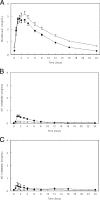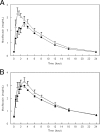Effects of rifampin and multidrug resistance gene polymorphism on concentrations of moxifloxacin
- PMID: 17517835
- PMCID: PMC1932492
- DOI: 10.1128/AAC.01621-06
Effects of rifampin and multidrug resistance gene polymorphism on concentrations of moxifloxacin
Abstract
Treatment regimens combining moxifloxacin and rifampin for drug-susceptible tuberculosis are being studied intensively. However, rifampin induces enzymes that transport and metabolize moxifloxacin. We evaluated the effect of rifampin and the human multidrug resistance gene (MDR1) C3435T polymorphisms (P-glycoprotein) on moxifloxacin pharmacokinetic parameters. This was a single-center, sequential design study with 16 volunteers in which sampling was performed after four daily oral doses of moxifloxacin (400 mg) and again after 10 days of combined rifampin (600 mg) and moxifloxacin. After daily coadministration of rifampin, the area under the concentration-time curve from 0 to 24 h (AUC(0-24)) for moxifloxacin decreased 27%. Average bioequivalence between moxifloxacin coadministered with rifampin and moxifloxacin alone was not demonstrated: the ratio of geometric means (RGM) of the moxifloxacin AUC(0-24) was 73.3 (90% confidence intervals [CI], 64.3, 83.5) (total P value, 0.87 for two one-sided t tests). Peak moxifloxacin concentrations, however, were equivalent: the RGM of the maximum concentration of the drug in serum was 93.6 (90% CI, 80.2, 109.3) (total P value, 0.049). Concentrations of the sulfate conjugate metabolite of moxifloxacin were increased twofold following rifampin coadministration (AUC(0-24), 1.29 versus 2.79 mug.h/ml). Concomitant rifampin administration resulted in a 27% decrease in the mean moxifloxacin AUC(0-24) and a marked increase in the AUC(0-24) of the microbiologically inactive M1 metabolite. Additional studies are required to understand the clinical significance of the moxifloxacin-rifampin interaction.
Figures


Similar articles
-
Intensified regimen containing rifampicin and moxifloxacin for tuberculous meningitis: an open-label, randomised controlled phase 2 trial.Lancet Infect Dis. 2013 Jan;13(1):27-35. doi: 10.1016/S1473-3099(12)70264-5. Epub 2012 Oct 25. Lancet Infect Dis. 2013. PMID: 23103177 Clinical Trial.
-
Repeated administration of high-dose intermittent rifapentine reduces rifapentine and moxifloxacin plasma concentrations.Antimicrob Agents Chemother. 2008 Nov;52(11):4037-42. doi: 10.1128/AAC.00554-08. Epub 2008 Sep 2. Antimicrob Agents Chemother. 2008. PMID: 18765687 Free PMC article. Clinical Trial.
-
Effect of administration of moxifloxacin plus rifampin against Mycobacterium tuberculosis for 7 of 7 days versus 5 of 7 days in an in vitro pharmacodynamic system.mBio. 2011 Jul 12;2(4):e00108-11. doi: 10.1128/mBio.00108-11. Print 2011. mBio. 2011. PMID: 21750119 Free PMC article.
-
A Review of Moxifloxacin for the Treatment of Drug-Susceptible Tuberculosis.J Clin Pharmacol. 2017 Nov;57(11):1369-1386. doi: 10.1002/jcph.968. Epub 2017 Jul 24. J Clin Pharmacol. 2017. PMID: 28741299 Free PMC article. Review.
-
Transporter and metabolizer gene polymorphisms affect fluoroquinolone pharmacokinetic parameters.Front Pharmacol. 2022 Dec 12;13:1063413. doi: 10.3389/fphar.2022.1063413. eCollection 2022. Front Pharmacol. 2022. PMID: 36588725 Free PMC article. Review.
Cited by
-
Advances in Drug Discovery and Development for Pediatric Tuberculosis.Mini Rev Med Chem. 2016;16(6):481-97. doi: 10.2174/1389557515666150722101723. Mini Rev Med Chem. 2016. PMID: 26202201 Free PMC article. Review.
-
The heterogeneous evolution of multidrug-resistant Mycobacterium tuberculosis.Trends Genet. 2013 Mar;29(3):160-9. doi: 10.1016/j.tig.2012.11.005. Epub 2012 Dec 13. Trends Genet. 2013. PMID: 23245857 Free PMC article. Review.
-
Clinical Relevance of Rifampicin-Moxifloxacin Interaction in Isoniazid-Resistant/Intolerant Tuberculosis Patients.Antimicrob Agents Chemother. 2022 Feb 15;66(2):e0182921. doi: 10.1128/AAC.01829-21. Epub 2021 Nov 22. Antimicrob Agents Chemother. 2022. PMID: 34807758 Free PMC article.
-
Role of therapeutic drug monitoring in the treatment of multi-drug resistant tuberculosis.J Clin Tuberc Other Mycobact Dis. 2024 Apr 24;36:100444. doi: 10.1016/j.jctube.2024.100444. eCollection 2024 Aug. J Clin Tuberc Other Mycobact Dis. 2024. PMID: 38708036 Free PMC article.
-
New drugs against tuberculosis: problems, progress, and evaluation of agents in clinical development.Antimicrob Agents Chemother. 2009 Mar;53(3):849-62. doi: 10.1128/AAC.00749-08. Epub 2008 Dec 15. Antimicrob Agents Chemother. 2009. PMID: 19075046 Free PMC article. Review. No abstract available.
References
-
- Burman, W. J., S. Goldberg, J. L. Johnson, G. Muzanye, M. Engle, A. W. Mosher, S. Choudhri, C. L. Daley, S. S. Munsiff, Z. Zhao, A. Vernon, R. E. Chaisson, and the Tuberculosis Trials Consortium. 2006. Moxifloxacin versus ethambutol in the first 2 months of treatment for pulmonary tuberculosis. Am. J. Respir. Crit. Care Med. 174:331-338. - PubMed
-
- Cancer Therapy Evaluation Program, National Cancer Institute. 30 April 1999, posting date. Common toxicity criteria, version 2.0. http://ctep.cancer.gov/forms/CTCv20_4-30-992.pdf.
-
- de Lange, E., S. Marchand, D. van den Berg, I. van der Sandt, A. de Boer, A. Delon, S. Bouquet, and W. Couet. 2000. In vitro and in vivo investigations on fluoroquinolones; effects of the P-glycoprotein efflux transporter on brain distribution of sparfloxacin. Eur. J. Pharm. Sci. 12:85-93. - PubMed
-
- Dilger, K., B. Greiner, M. F. Fromm, U. Hofmann, H. K. Kroemer, and M. Eichelbaum. 1999. Consequences of rifampin treatment on propafenone disposition in extensive and poor metabolizers of CYP2D6. Pharmacogenetics 9:551-559. - PubMed
-
- Eichelbaum, M., M. Fromm, and M. Shwab. 2004. Clinical aspects of the MDR1 (ABCB1) gene polymorphism. Ther. Drug Monit. 26:180-185. - PubMed
Publication types
MeSH terms
Substances
Grants and funding
LinkOut - more resources
Full Text Sources
Medical

